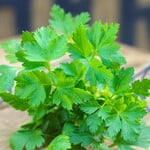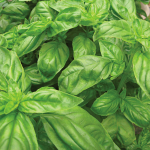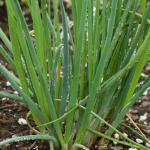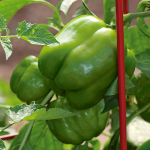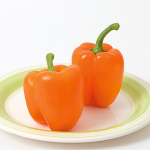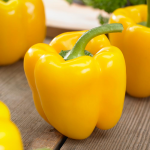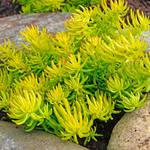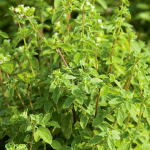Product Details
Carefully selected for ease of growing, this set of classic culinary herbs for beginners includes six sturdy plants to pop right into your garden or containers. Brush the leaves or pick a few to enjoy their scents and flavors while you're in the garden. Of course, having fresh herbs is endlessly useful in the kitchen. Our collection is a perfect way to start an herb garden and makes a fine gift for a beginner gardener or anyone who enjoys cooking with the best ingredients. All of the plants in this collection, except for the Basil, are hardy to Zone 6. One plant of each variety listed below, 6 plants total.
- Chives —A fancy European strain, Fine Chives grow into the same 1′ tall clumps as regular Chives (Allium schoenoprasum), but their leaves are more refined and tender, tend to regrow faster after cutting, and develop woody stems more slowly.
- Italian Oregano (Origanum x majoricum)—A staple in the herb garden that's quite carefree once established. Provides a robust, zesty flavoring to Italian and Mexican dishes.
- Golden Lemon Thyme (Thymus x citriodorus 'Golden Lemon')—Delightful for both the kitchen and the garden with its lemon scent and bright golden-edged leaves. A natural partner with any chicken dish and adds a lemony lift to vegetables, rice, and casseroles.
- Basil 'Caesar'—Large, succulent leaves up to three inches long. Plants are slow to flower, affording a long harvest of tender, very flavorful foliage. Excellent for aromatic pestos, sauces, and tomato salads!
- Flat-leaf Parsley (Petroselinum crispum var. neapolitanum)—This variety's sweet, strong flavor makes it the chef's favorite for everyday cooking. Superb in any slow-cooking dish; rich in both flavor and vitamins.
- Culinary Sage (Salvia officinalis)—A traditional herb for poultry stuffing and perfect with pork, sausage, and cheese. Lovely, soft gray foliage.
Shipping
HOW PLANTS ARE SHIPPED
The size of the plants we ship has been selected to reduce the shock of transplanting. For some, this means a large, bareroot crown. Others cannot travel bareroot or transplant best if grown in containers. We ship these perennials and annuals in 1 pint pots, except as noted. We must point out that many perennials will not bloom the first year after planting, but will the following year, amply rewarding your patience. We ship bulbs as dormant, bare bulbs, sometimes with some wood shavings or moss. Shrubs, Roses, vines, and other woody plants may be shipped bareroot or in pots. The size of the pot is noted in the quick facts for each item.
WHEN WE SHIP
We ship our bulbs and plants at the right time for planting in your area, except as noted, with orders dispatched on a first-come, first-served basis by climate zone. We also ship a wide range of containers and planters, tools, supplies, fertilizers, garden wear, garden decor items, as well as indoor decorations like wreaths and dried bouquets when available. Estimated dates for shipping are indicated in the green Shipping Details box for each item. Please supply a street address for delivery. Kindly contact us with two weeks notice, if you'll be away at the expected time of delivery.
OUR GUARANTEE
We guarantee to ship plants that are in prime condition for growing. If your order is damaged or fails to meet your expectations, we will cheerfully replace or refund it. Please contact our Customer Service Department at 1-800-503-9624 or email us at [email protected]. Please include your order number or customer number when contacting us.
Reviews
There are no reviews yet. Be first to Write a Review.
Growing guide
If you must delay planting herb plants:
Open the shipping box and packaging and remove the pots as soon as possible after arrival. Your plants will need light, air circulation, and proper moisture. If you can't plant within a day or so, put them in a sheltered spot that gets strong light (but not hot sunshine) and water them only when the top inch of soil is dry to the touch. Plan to transplant the herbs out of their pots into their permanent location as soon as possible. Be sure they do not dry out, but do not over-water since they won't stand well in soggy soil.
Planting:
Potgrown plants that arrive in active growth need a gradual introduction to direct sun and wind before planting. Set plants outdoors in a sheltered, lightly shaded spot, increasing their exposure to sun and wind each day. After 7-10 days, they will be ready to go in the ground.
When ready to plant, pick a spot in the garden or a location for your permanent herb container that is in full sun with good drainage and moderately rich soil. (See Growing Herbs in Containers Outdoors for specific container advice.) Dig a hole that is large enough to accommodate the plant's root ball very comfortably. Plants are well rooted in their pots, so to remove them for planting, flip the whole shipping pot over and slip out the plant and its root ball, rather then pulling out the plant.
If the plant is root-bound (the root ball matted with roots to the point that they obscure the potting mix), gently break up the sides of the ball with your thumbs and tease apart roots that are circling at the bottom. This encourages roots to grow out into the surrounding soil. Set the plant and its root ball into the hole and replace soil around the root ball, planting to the same depth it was in the shipping pot. Press the soil firmly around the plant with your hands to eliminate air pockets and establish good soil contact. A gentle but thorough watering will help settle the soil around the plant. Try to transplant your herb plants in the morning or late afternoon to avoid shock if the weather is hot and sunny. Keep newly transplanted herb plants moist but not soggy.
French Thyme and Lemon Thyme, (Thymus x. citriodorus). Perennial Hardy Thymes grow in a soft compact mound about 12 inches across and 8 inches high. Plant Thyme in full sun, in moderately rich and very well-drained soil. Feed lightly once a year in spring. Plants are quite hardy; in very cold winter areas, give winter protection with straw, salt hay, or oak leaves. Thyme is a non-fussy plant and usually grows disease- and pest-free.
Cooking with Thyme:
Thyme's origins are in the Mediterranean area where it was much loved by the Greeks and Romans. Thyme is a natural pair with any chicken dish, a perfect herb for seasoning rice and grain dishes, and adds a delightful lift to vegetables and casseroles. It makes a delicate herb butter.
Culinary Sage: Sage (Salvia officinalis) grows into a substantial semi-woody plant, perhaps 2 feet tall or more. Plant in full sun in well-drained soil, and allow room for future growth. The aromatic, pointed leaves are a handsome greenish gray. Plants tend not to be long-lived, so plan to replace them every 3 or 4 years.
Cooking with Sage:
Sage is a natural with chicken and turkey, and with bean and sausage dishes. The flavor is quite strong, so use with a light hand.
Rosemary, (Rosmarinus officinalis) Tender Perennial. Rosemary plants grow into 2 to 3 foot aromatic evergreen shrubs with thin, piney-scented gray-gray leaves. Native to the Mediterranean, the Latin name means "dew of the seas." Rosemary needs a spot with full sun, and must have excellent drainage and good air circulation to grow well. Water it only enough to keep the plant from drying out. Feed lightly once a year in spring. In mild-winter areas, where ground doesn't freeze, Rosemary can be planted right in the ground. In cold winter areas with ground-freezing frosts, Rosemary should be grown in a pot or other container outside over the warm summer season and then brought inside during the cold weather. Do not repot often as this causes shock. Cut back your Rosemary about ⅓ before bringing it indoors to overwinter in a spot that gets a maximum of light. After several years, carefully repot your Rosemary into a slightly larger container. Given the above good growing conditions, Rosemary rarely has problems with insects or disease.
Cooking with Rosemary:
Stuff chickens with sprigs of fresh Rosemary, add garlic, and spit-roast over hot coals; when you grow your own plants, you can afford to be lavish! Rosemary's strong-but-subtle piney-mint taste makes an excellent herb butter. Try with tomatoes and cheeses, too.
Tarragon, (Artemisia dracunculus var. sativa). Perennial. An herbaceous 2 to 3 foot tall branching perennial with narrow leaves, Tarragon is used by cooks around the world and prized for its unique flavor. Ours is the true French Tarragon, a mostly sterile form of the wild species, having been carefully selected for centuries by the cooks of Europe.
Your Tarragon plants may have been shipped to you as dormant bare root plants. Do not be concerned if they have no evident growth; this is the natural condition of dormant plants. They will sprout and begin active growth from healthy roots soon after you plant them, which should be as soon as possible after receiving them. The field-grown plants are wrapped in plastic film and sphagnum moss or shredded paper to protect delicate roots. Unwrap them only when ready to plant, keeping the roots moist by not exposing them to wind or bright sun.
When you have prepared a sunny spot with well drained soil, plant so that soil level is 1 to 1 1/2 inches above the topmost roots. Protect any white shoots that may have grown during shipment with a little loose straw or leaf mulch until they green up, which should just take a few days.
Tarragon is at its best in full sun, but will tolerate very light shade. It likes a deep, rather rich, well-drained soil. Perennial Tarragon will die back to its roots in winter and grow again every spring. The plants do tend to lose their vigor after several years, at which time they should be dug in the early spring and replanted, using pieces of the best roots. In cold winter areas with regular ground-freezing frosts and snow, provide winter protection for Tarragon plants with straw, salt marsh hay, or oak leaves. Aphids are about the only serious pest problem and can easily be controlled with pyrethrum, rotenone, or insecticidal soap.
Cooking with Tarragon:
Chicken and fish are natural pairs with Tarragon; it is wonderful with mushrooms, spinach, leeks, and potatoes, and essential in bearnaise and many creamy sauces. Make your own Tarragon vinegar by storing fresh branches in a good wine vinegar.
Lavenders, (Lavendula spp.) Perennial. (Please note: 'Goodwin Creek Grey' is more tender than most Lavenders, suriving winters only in Zone 7 or warmer.) Most of the Lavender varieties we sell will reach from 18 inches to 2 1/2 feet tall at maturity (after several growing seasons) with a vigorous, many branching habit and intensely perfumed, branching flower spikes.
Lavender needs a warm garden spot with very well drained, good garden soil in full sun. Keep well watered but not at all soggy, as Lavender will not tolerate having its roots in overwet soil. It likes alkaline soil conditions, so if your soil is very acid, add horticultural lime. Because Lavender plants have strong essential oils, they are rarely bothered by common plant pests nor do deer munch them. Remember their requirements for good drainage, warmth, and minimal feeding and watering for best results.
Harvesting and Using Lavender:
Flower spikes have the strongest scent just as the pretty little flowers begin to open. Cut long stems and gather in bunches to dry out of the sun. Spread on a screen or sheet so air circulates easily. Drying takes just 4 to 5 days in warm weather. Use the stems of fresh or dried flower spikes in arrangements or remove the florets for sachets and potpourri mixtures.

